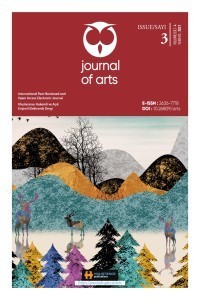Çocuk kitaplarında değişen yaklaşımlar; postmodern tasarlama
Postmodernizm birden çok perspektifi olan çok kültürlü bir anlatıdır (Doll, 1993). Yaklaşık son on yıldır resimli çocuk kitaplarında “postmodern” tanımlaması içeren bir alt tür ortaya çıkmıştır. Çocuğa bilinçli olarak verilen eksik veya çelişkili metinler ve görseller, farklı düşünme, yorumlama biçimlerini teşvik etmek üzere tasarlanmıştır. Geleneksel yaklaşımdaki resimli kitap fikrini yıkmak üzere harekete geçmiş bu kitaplar, ironik, bağlantısız kurguları ile çocukları hatta yetişkinleri yaratıcı yorumlamalara teşvik etmekte, ayrıksı konu bağlantıları ile şaşırtmaktadır. Alışılmadık olay örgüsü ile metinlerarasılık, parodi, tasarım düzeni, resimli yazı tipleri ve perspektifleri ile doğrusal anlatım biçimleri içermeyen bu kitaplar, üstkurmaca özellikler taşımaktadır. Geleneksel görsel çözümleme yöntemlerini kullanmayan postmodern resimli çocuk kitapları, görsel yorumlama biçiminin okuyucuya bırakıldığı bir alan yaratmaktadır. Okuyucuyu, alışılmadık tasarısı ile doğrusal olmayan alanlarda gezinmeye ve bu metinlerin doğasında bulunan karmaşıklıkları anlamlandırmak üzere görsel kodları çözmeye davet etmektedir.
Bu makale, çocuk kitabı tasarlamada, “postmodern çocuk kitabı” koşullarını hazırlayan yaklaşımları ve okuyucu açısından gelişen algılama biçimlerini irdeleyecektir.
Anahtar Kelimeler:
Çocuk Kitapları, Postmodern, Tasarım, Üstkurmaca, İllüstrasyon
Changing approaches in children's books; postmodern design
Postmodernism is a multicultural narrative with multiple perspectives (Doll, 1993). In the last ten years, a sub-genre with the definition of “postmodern” has emerged in children's picture books. Incomplete or contradictory texts and images given to the child consciously are designed to encourage different ways of thinking and interpretation. Taking action to demolish the traditional idea of picture books, these books encourage children and even adults to creative interpretations with their ironic, disconnected fictions, and surprise with their distinctive subject connections. These books, which do not contain unusual plot and intertextuality, parody, design layout, pictorial fonts and perspectives, and linear narrative styles, have metafictional features. Postmodern children's picture books, which do not use traditional visual analysis methods, create a space where the form of visual interpretation is left to the reader. With its unusual design, it invites the reader to navigate non-linear spaces and decode the visual codes to make sense of the complexities inherent in these texts. This article will examine the approaches that prepare the conditions for the "postmodern children's book" in designing children's books, and the perceptions that develop in terms of the reader.
Keywords:
Chilren's Books, Postmodern, Design, Metafiction, Illustration,
___
- ANSTEY, M. & BULL, G. (2000) Reading the Visual: Written and Illustrated Children’s Literature. Sydney, Harcourt.
- ANSTEY, M. (2002, March). "It's not all black and white": Postmodem picture books and new literacies. Journal oj Adolescent & Adult Literacy, 4.5,444-457.
- ANSTEY, MİCHELE, & BULL, GEOFF. (2006). Teaching and Learning Multiliteracies: Changing Times, Changing Literacies Newark, DE: International Reading Association.
- BADER, BARBARA. American Picturebooks from Noah’s Ark to the Beast Within. New York : Macmillan Pub. Co., 1976.
- DRESANG, ELİZA T. (1999). Radical Change: Books for Youth in a Digital Age. New York: The H.W. Wilson Company.
- FEHR, D. E. (1997). Clutching the lectern, or shouting from the back of the hall: A comparison of modern and postmodern arts education. Arts Education Policy Review, 98, 27-31.
- HARPER, L. J. ,& S. TROSTLE- BRAND (2010). ”More Alike Than Defferent: Promoting Respect Through Multicultural Books and Literacy Strategies.” Childhood Education 86(4):224-33
- GOLDSTONE, B. P. (2002). Whaz up with our books? changing picture book codes and teaching implications. Reading Teacher, 55,362-350
- MACKEY, M. , & MCCLAY, J. K. (2000, October). Graphic routes to electronic literacy: Polysemy and picture books. Changing English: Studies in Reading & Culture, 7, 191-201.
- MİTCHELL, F. M. , & NELMS, V. C. (1992). Using children's literature in the art curriculum. In A. Johnson (Ed.), Art Education: Elementary (pp.187-199). Reston, VA: National Art Education Association
- NODELMAN, PERRY. (1996). Illustration and Picture Books, in International Encyclopedia of Children‘s Literature, Peter Hunt, ed., pp. 113–124. London: Routledge.
- SERAFİNİ, F. (2004). Lessons in Comprehension: Explicit Instruction in the reading workshop. Portsmouth, NH: Heinemann.
- SERAFİNİ, L.R. (2011 November). Expanding Perspectives for Comprehending Visual Images in Multimodal Texts. International Literacy Association, 54(5),342-350.
- SİPE, L. R., & MCGUİRE, C. E. (2006). Picturebook endpapers: Resources for literary and aesthetic interpretation. Children’s Literature in Education, 37(4), 291–304.
- SMİTH, F. (1988). Joining the literacy club: Further essays into education. Portsmouth, NH: Heinemann Publishing.
- TRİTES, R.S. (1994, December). Manifold narratives: Metafiction and ideology in picture books. Children s Literature in Education, 2.5, 225-242.
- ISSN: 2636-7718
- Başlangıç: 2018
- Yayıncı: Holistence Publications
